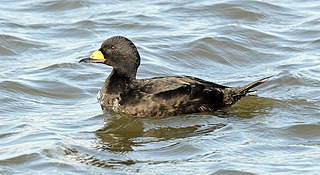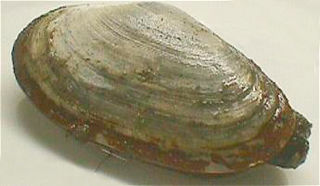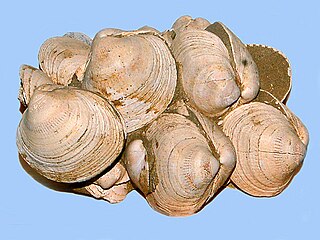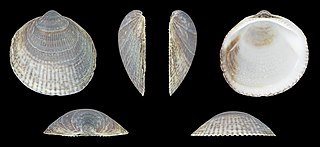
Clam is a common name for several kinds of bivalve molluscs. The word is often applied only to those that are edible and live as infauna, spending most of their lives halfway buried in the sand of the seafloor or riverbeds. Clams have two shells of equal size connected by two adductor muscles and have a powerful burrowing foot. They live in both freshwater and marine environments; in salt water they prefer to burrow down into the mud and the turbidity of the water required varies with species and location; the greatest diversity of these is in North America.

Cowrie or cowry (pl. cowries) is the common name for a group of small to large sea snails in the family Cypraeidae.

The black scoter or American scoter is a large sea duck, 43 to 49 cm in length. The genus name is derived from Ancient Greek melas "black" and netta "duck". The species name is from the Latin for "American".

Soft-shell clams or Sand gaper, scientific name Mya arenaria, popularly called "steamers", "softshells", "piss clams", "Ipswich clams", or "Essex clams", are a species of edible saltwater clam, a marine bivalve mollusk in the family Myidae.
The shells of large saltwater bittersweet clams in the genus Glycymeris have a special archaeological significance in the southwestern USA, because the shells were used in trade item production by the Hohokam tribe of Amerindians. In this context the shells are known to archeologists as "Glycymeris shells".

The Atlantic surf clam, also called the bar clam, hen clam, skimmer or simply sea clam, is a very large, edible, saltwater clam or marine bivalve mollusk in the family Mactridae. It is one of the most commonly found species of bivalves in the western Atlantic Ocean. Able to reach sizes between 7.9 and 8.9 inches in length, Atlantic surf clams are much larger than Spisula solida, which also resides in the eastern Atlantic coastal waters. Atlantic surf clams reproduce in late summer, when the water temperatures peak.

Glycymerididae, often misspelled as Glycymeridae, common names dog cockles or bittersweets, is a worldwide family of salt water clams, marine bivalve mollusks in the order Arcida. They are related to the ark clams. This family contains 45 extant species in four genera.

The dog cockle or European bittersweet is a species of marine clam, a coastal bivalve mollusc of European waters.

Perna perna, the brown mussel, is an economically important mussel, a bivalve mollusc belonging to the family Mytilidae. It is harvested as a food source but is also known to harbor toxins and cause damage to marine structures. It is native to the waters of Africa, Europe, and South America and was introduced in the waters of North America.

Glycymeris decussata, or the decussate bittersweet, is a species of bivalve mollusc in the family Glycymerididae. It can be found in Caribbean waters, ranging from Florida to the West Indies and Brazil.

Tucetona pectinata, or the comb bittersweet, is a species of bivalve mollusc in the family Glycymerididae.

Glycymeris undata, or the Atlantic bittersweet, is a species of bivalve mollusc in the family Glycymerididae. It can be found along the Atlantic coast of North America, ranging from North Carolina to the West Indies and Brazil.

Nodipecten nodosus, or the lion's paw scallop, is a species of bivalve mollusc in the family Pectinidae. It can be found along the Atlantic coast of North America, ranging from Cape Hatteras to the West Indies, including Brazil and Bermuda.

Anomia simplex, the common jingle shell, is a typical species of bivalve mollusc in the family of Anomiidae, sharing attributes to blue mussels, American oysters, and bay scallops. Species related to the family of Anomiidae are often noted for their extremely thin, often translucent, paper-like shells. Anomia simplex can be found in shallow waters, typically estuaries, mainly along the Atlantic Coast of North America; however, they can range as far north as the coast of Nova Scotia, and as far south as the coast of Brazil.

Glycymeris, common name the bittersweet clams, is a genus of saltwater clams, marine bivalve molluscs in the family Glycymerididae.

Shell jewelry is jewelry that is primarily made from seashells, the shells of marine mollusks. Shell jewelry is a type of shellcraft. One very common form of shell jewelry is necklaces that are composed of large numbers of beads, where each individual bead is the whole shell of a small sea snail. Numerous other varieties of shell jewelry are made, including bracelets and earrings.

Glycymeris aspersa, common name the clothed bittersweet, is a species of saltwater clam, a marine bivalve mollusc in the family Glycymerididae, the bittersweets.

Glycymeris nummaria is a species of saltwater clam, a marine bivalve mollusc in the family Glycymerididae, the bittersweet clams.

Glycymeris yessoensis is a species of bivalve mollusc in the family Glycymerididae. It can be found burrowing in soft sediment in shallow water in the Pacific Ocean around the coasts of China and Japan. It is often associated with a polychaete worm with which it forms a commensal relationship.

Glycymeris longior is a species of marine bivalve of the family Glycymerididae. The shells of this species are frequently found on beaches from Patagonia to Brazil. It was common in the Quaternary on the Atlantic coast of South America.



















